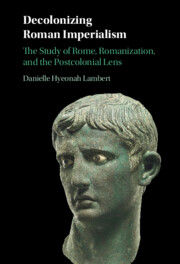Refine search
Actions for selected content:
23916 results in Ancient history
Dedication
-
- Book:
- Decolonizing Roman Imperialism
- Published online:
- 03 October 2024
- Print publication:
- 17 October 2024, pp v-vi
-
- Chapter
- Export citation
Historical Intervention
-
- Book:
- Decolonizing Roman Imperialism
- Published online:
- 03 October 2024
- Print publication:
- 17 October 2024, pp 197-205
-
- Chapter
- Export citation
Acknowledgements
-
- Book:
- Decolonizing Roman Imperialism
- Published online:
- 03 October 2024
- Print publication:
- 17 October 2024, pp viii-viii
-
- Chapter
- Export citation
Chapter 2 - Postcolonial Themes
-
- Book:
- Decolonizing Roman Imperialism
- Published online:
- 03 October 2024
- Print publication:
- 17 October 2024, pp 51-80
-
- Chapter
- Export citation
Chapter 3 - Postcolonial Questions in the Age of Decolonization
-
- Book:
- Decolonizing Roman Imperialism
- Published online:
- 03 October 2024
- Print publication:
- 17 October 2024, pp 81-150
-
- Chapter
- Export citation
Introduction
-
- Book:
- Decolonizing Roman Imperialism
- Published online:
- 03 October 2024
- Print publication:
- 17 October 2024, pp 1-14
-
- Chapter
- Export citation
Chapter 4 - Towards a Paradigm Shift in the Age of Globalization
-
- Book:
- Decolonizing Roman Imperialism
- Published online:
- 03 October 2024
- Print publication:
- 17 October 2024, pp 151-196
-
- Chapter
- Export citation
Index
-
- Book:
- Decolonizing Roman Imperialism
- Published online:
- 03 October 2024
- Print publication:
- 17 October 2024, pp 225-228
-
- Chapter
- Export citation
Contents
-
- Book:
- Decolonizing Roman Imperialism
- Published online:
- 03 October 2024
- Print publication:
- 17 October 2024, pp vii-vii
-
- Chapter
- Export citation
Copyright page
-
- Book:
- Decolonizing Roman Imperialism
- Published online:
- 03 October 2024
- Print publication:
- 17 October 2024, pp iv-iv
-
- Chapter
- Export citation

Decolonizing Roman Imperialism
- The Study of Rome, Romanization, and the Postcolonial Lens
-
- Published online:
- 03 October 2024
- Print publication:
- 17 October 2024
Appendix 8.3 - Salinator’s Triumph – or Nero’s Also?
- from Chapter 8 - The Tipping Point
-
- Book:
- Hannibal and Scipio
- Published online:
- 05 September 2024
- Print publication:
- 26 September 2024, pp 201-201
-
- Chapter
- Export citation
Chapter 8 - The Tipping Point
-
- Book:
- Hannibal and Scipio
- Published online:
- 05 September 2024
- Print publication:
- 26 September 2024, pp 182-206
-
- Chapter
- Export citation
Additional material
-
- Book:
- Hannibal and Scipio
- Published online:
- 05 September 2024
- Print publication:
- 26 September 2024, pp xix-xix
-
- Chapter
- Export citation
Chapter 16 - Hannibal and Scipio
-
- Book:
- Hannibal and Scipio
- Published online:
- 05 September 2024
- Print publication:
- 26 September 2024, pp 337-368
-
- Chapter
- Export citation
Prologue
-
- Book:
- Hannibal and Scipio
- Published online:
- 05 September 2024
- Print publication:
- 26 September 2024, pp 1-8
-
- Chapter
- Export citation
Chapter 18 - The Downfall and Death of Scipio, 187–183
-
- Book:
- Hannibal and Scipio
- Published online:
- 05 September 2024
- Print publication:
- 26 September 2024, pp 384-394
-
- Chapter
- Export citation
Appendix 1.2 - Plutarch’s Lost Lives of Scipio
- from Chapter 1 - Hannibal and Scipio on Themselves
-
- Book:
- Hannibal and Scipio
- Published online:
- 05 September 2024
- Print publication:
- 26 September 2024, pp 31-33
-
- Chapter
- Export citation
Reviews
-
- Book:
- Hannibal and Scipio
- Published online:
- 05 September 2024
- Print publication:
- 26 September 2024, pp ii-ii
-
- Chapter
- Export citation
Chapter 14 - Hannibal Flees to Antiochus III; His Intrigues; 195–193
-
- Book:
- Hannibal and Scipio
- Published online:
- 05 September 2024
- Print publication:
- 26 September 2024, pp 298-302
-
- Chapter
- Export citation
